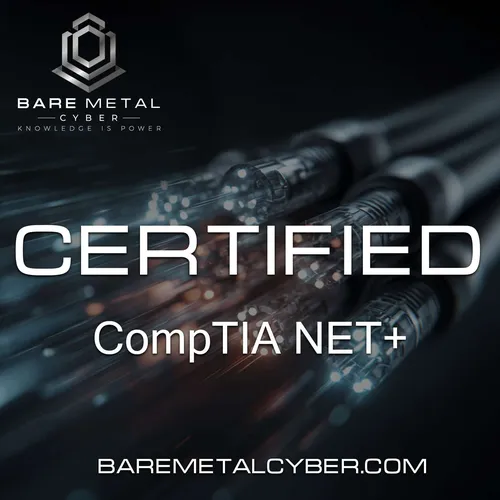
Certified - CompTIA Network + Audio Course
The Network Plus Audio Course is your comprehensive audio training series for mastering the CompTIA Network Plus certification. Designed for learners on the go, this prepcast transforms exam objectives into clear, structured, and engaging episodes tailored for auditory learning. Whether you're walking, commuting, or studying between shifts, each episode breaks down complex networking topics into digestible segments aligned with the official CompTIA blueprint. From OSI layers and IP addressing to wireless standards and troubleshooting methodologies, the series leaves no objective unexplored.
Created by Bare Metal Cyber, a trusted name in cybersecurity education, this prepcast doesn’t just teach — it prepares you for the exam format itself. You’ll learn how to approach multiple-choice questions, understand tricky phrasing, and think like a test writer. Every episode is fully narrated for machine voice clarity, making it perfect for repetition and review. Whether you're a first-time test taker or recertifying, the Network Plus PrepCast helps you build the confidence and competence to pass the exam and succeed in your networking career.
- Update frequency
- every day
- Average duration
- 14 minutes
- Episodes
- 184
- Years Active
- 2025

Episode 44: PAT — Port Address Translation and Overload NAT
This episode focuses on Port Address Translation (PAT), often called overload NAT, which extends NAT by allowing multiple devices to share one public IP using different port numbers. PAT is critical …

Episode 43: NAT — Hiding Networks Behind a Single IP
This episode introduces Network Address Translation (NAT), a process that allows multiple internal devices to share a single public IP address. It explains the core function of NAT in conserving IPv4…

Episode 42: Public vs. Private Addressing — What You’re Allowed to Use
This episode explains the difference between public and private IP addresses and why the distinction is important for both exam and real-world environments. Public addresses are globally routable and…

Episode 41: Introduction to IP Addressing and Subnetting
This episode introduces the fundamentals of IP addressing and subnetting, two of the most critical skills for the Network Plus exam. It explains how IP addresses identify hosts on a network and how s…

Episode 40: Ethernet Standards over Fiber and Multiplexing
This episode introduces Ethernet standards over fiber optic cabling, which enable high-speed communication across longer distances than copper. Standards such as 1000BASE-LX, 10GBASE-SR, and 40GBASE-…

Episode 39: Ethernet Standards over Copper
This episode explains the Ethernet standards that operate over copper cabling, from early Fast Ethernet to Gigabit and 10 Gigabit Ethernet. It describes how cable categories, frequencies, and distanc…

Episode 38: Cable Management, Panels, and Punchdowns
This episode highlights the importance of proper cable management, distribution panels, and punchdown blocks in maintaining organized, functional networks. It explains how patch panels centralize con…

Episode 37: Media Converters — Bridging the Gap
This episode explains media converters, devices that enable communication between different types of physical cabling, such as copper to fiber or single-mode to multimode fiber. Media converters play…

Episode 36: Transceiver Modules — Plugging Light into Switches
This episode introduces transceiver modules, which enable switches, routers, and other network devices to interface with fiber or copper cabling. Standards such as SFP, SFP+, QSFP, and GBIC are expla…

Episode 35: Common Fiber and Copper Connector Types
This episode focuses on the various connector types used with fiber and copper cabling. For fiber, common connectors include ST, SC, LC, and MTP/MPO, each with specific use cases and physical charact…

Episode 34: Single-Mode vs. Multimode Fiber
This episode explains the differences between single-mode and multimode fiber, two types of optical cabling defined by how light travels through the core. Single-mode fiber, with its narrow core, sup…

Episode 33: Understanding Fiber Optic Cabling
This episode introduces fiber optic cabling, which transmits data as pulses of light rather than electrical signals. Fiber provides high bandwidth, long-distance capability, and immunity to electroma…

Episode 32: Termination Standards — TIA/EIA-568A vs. 568B
This episode introduces the TIA/EIA-568A and TIA/EIA-568B cabling standards, which define how twisted pair cables are terminated for reliable network communication. It explains the wire color codes a…

Episode 31: Coaxial and Twinaxial Cables
This episode covers coaxial and twinaxial cables, two copper-based media types that still appear in both exam questions and some practical environments. Coaxial cable uses a central conductor surroun…

Episode 30: Twisted Pair Cabling Standards — Cat 5, 5e, 6, 6a, and Beyond
This episode examines twisted pair cabling standards, including Category 5, 5e, 6, 6a, and higher classifications. Each standard is defined by its maximum transmission speed, frequency, and distance …

Episode 29: Introduction to Transmission Media and Copper Cabling
This episode introduces transmission media, focusing on copper cabling as one of the most widely used network media types. It explains how copper cables transmit electrical signals and introduces the…

Episode 28: Network Provider Links — From Satellite to Metro Optical
This episode explains the variety of network provider links that organizations use to connect geographically dispersed sites. It introduces technologies such as satellite communications, microwave, D…

Episode 27: Network Function Virtualization (NFV) in Practice
This episode introduces Network Function Virtualization (NFV), which replaces traditional hardware-based appliances like routers, load balancers, and firewalls with software-based equivalents. NFV en…

Episode 26: Virtual Network Interfaces and Components
This episode explores virtual network interfaces and components, which allow logical networking functions to operate independently of physical hardware. A virtual network interface card (vNIC) enable…

Episode 25: Network Entry Points — Demarcation and Smartjacks
This episode covers network entry points, specifically the concepts of demarcation points and smartjacks. A demarcation point is where the responsibility of the service provider ends and the customer…